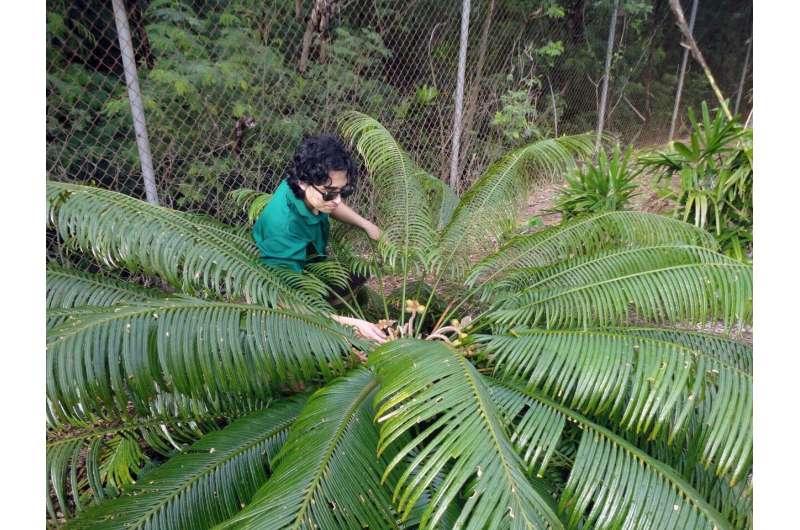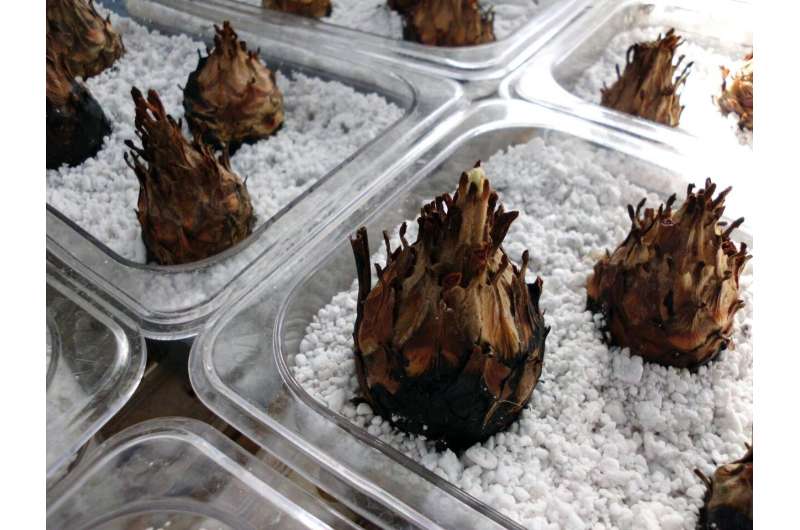Study finds go-to hormone for cycad propagation ineffective

The newly published thesis research of University of Guam Master of Environmental Science graduate Benjamin Deloso now adds to the body of knowledge about asexual propagation of the most endangered plant group in the world, cycads. His work was part of a set of UOG studies, all focused on improving the asexual propagation of cycads, published in the September 2020 issue of HortScience, one of the oldest horticultural journals in the United States.
With the assistance of his professors, Deloso designed a set of experiments to examine the speed of adventitious rooting in "pups," external stems produced from parent plants. He used two species of Zamia, a group of cycads native to the New World. These model species were chosen for two replicated rooting studies utilizing indole-3-butyric acid (IBA), the most common rooting hormone used in asexual propagation protocols.
Cycad horticulturists typically employ the use of IBA in asexual propagation, and previous research utilizing IBA on angiosperms, or flowering plants, suggests that an ideal concentration of IBA exists for cycads. However, the efficacy of IBA on cycads was unknown. "Do cycads actually benefit from IBA?" wondered Deloso, lead author of the study.
"That was one of our objectives," he said. "So we included a range of IBA that was 10 times higher than the dose that is most commonly used in commercial horticultural operations to see if there would be a negative response."
In contrast to all expectations, the cycad stem cuttings did not appear to benefit from any of the IBA doses used as the control groups performed just as well as the other treatment groups.
"The results were surprising. Our research illuminates how much is still unknown about cycad biology and highlights how different they are from other groups of plants," Deloso said.

This knowledge could benefit cycad conservation in countries where commercial IBA products are difficult to obtain.
Previous asexual propagation studies utilizing cycad stem cuttings did not involve the use of a range of IBA nor did they include a control group.
"After reviewing the scientific literature, it was clear that previous studies did not employ typical horticultural protocols," said Frank Camacho, UOG associate professor of biology and one of the authors of the study.
This makes Deloso's study the first of its kind in the cycad horticulture literature.
While IBA may not influence successful propagation of Zamia cycads, Deloso's study notes that additional studies are needed to determine its effectiveness on the other 300- plus cycad species, in particular those that are threatened, such as the endemic Cycas micronesica of Guam, Rota, Yap, and Palau. He also noted other factors found in his previous research that have proven to assist the propagation process.
"Our previous research has highlighted the relative ease of asexually propagating cycad plants. High survivability is achieved when hygienic conditions are adhered to, cuttings are obtained from healthy plants, the cut surfaces are covered with a sealant to prevent desiccation, the growing medium exhibits adequate aeration and drainage capacity, and underwatering during the propagation phase is followed," Deloso said.
Anders Lindström of the Nong Nooch Tropical Botanical Garden, another author of the study, said he is encouraged by the results of the study, saying, "Continued improvements in cycad horticulture are of great importance to the conservation of this unique plant group. We ... look forward to collaborating more with the University of Guam in the future."
More information: Benjamin E. Deloso et al, Highly Successful Adventitious Root Formation of Zamia L. Stem Cuttings Exhibits Minimal Response to Indole-3-Butyric Acid, HortScience (2020). DOI: 10.21273/HORTSCI15212-20
Journal information: HortScience
Provided by University of Guam


















